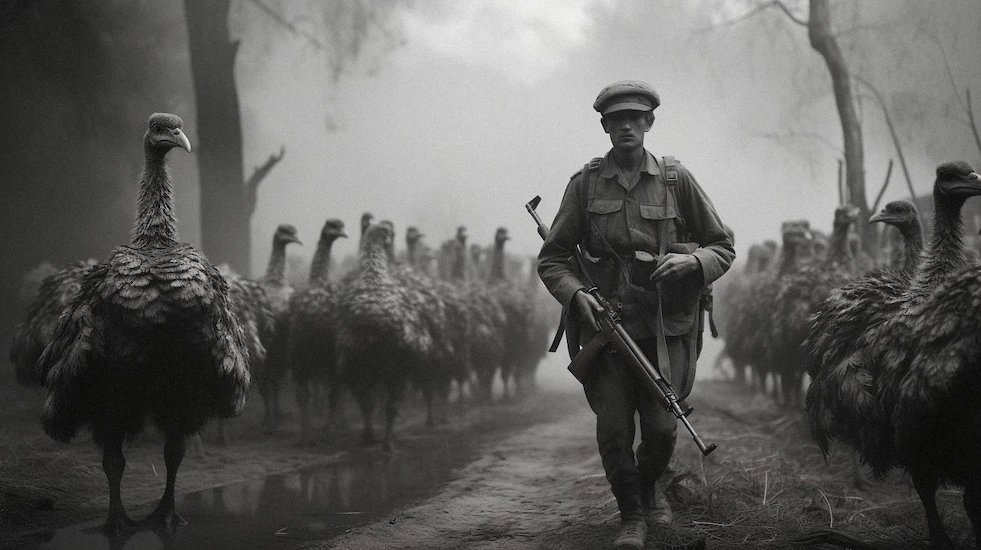The Great Emu War: When Australia Fought Against Birds
May 27, 2024
Humor History

The Great Emu War of 1932 is one of the most bizarre and intriguing episodes in Australian history. This peculiar conflict saw the Australian government deploying military forces against a large population of emus, the flightless birds native to the continent. The story is a fascinating blend of unintended consequences, military missteps, and the resilience of nature. In this blog, we will explore the events leading up to the Great Emu War, the tactics employed, and the aftermath of this unusual battle.
Background: The Post-War Struggles
The Plight of the Farmers
In the early 1930s, Australia was grappling with the aftermath of World War I and the Great Depression. Many soldiers returning from the war were given land in Western Australia to take up farming as part of a government resettlement scheme. However, these new farmers faced numerous challenges, including harsh environmental conditions, declining wheat prices, and financial hardship.
The Emu Invasion
As if these difficulties weren't enough, the farmers found themselves battling another unexpected adversary: emus. Emus are large, flightless birds that can grow up to six feet tall and run at speeds of up to 30 miles per hour. In 1932, an estimated 20,000 emus migrated from the inland regions to the coastal farmlands of Western Australia in search of food and water. The emus trampled crops, damaged fences, and caused significant destruction to the farmers' already struggling livelihoods.
The Call for Military Intervention
Pleas for Help
Desperate for a solution, the farmers turned to the government for assistance. They requested military support to deal with the emu problem, arguing that the birds were a significant threat to their wheat crops and their economic survival. The government, under pressure to support the struggling farmers, agreed to deploy military resources to address the emu invasion.
Deployment of Troops
In November 1932, Major G.P.W. Meredith of the Royal Australian Artillery was assigned to lead the operation. Armed with two Lewis machine guns and 10,000 rounds of ammunition, Meredith and his small team were sent to the Campion district in Western Australia to combat the emu menace. The operation was expected to be a quick and decisive victory against the feathered invaders.
The Battle Begins
Initial Encounters
The first encounter between the soldiers and the emus took place on November 2, 1932. However, the emus proved to be surprisingly elusive and difficult to target. The birds moved swiftly and unpredictably, scattering into smaller groups whenever the soldiers approached. Despite their best efforts, the soldiers managed to kill only a small number of emus during the initial skirmishes.
Tactical Adjustments
Realizing the futility of their initial approach, Major Meredith and his team attempted to modify their tactics. They set up ambushes near watering holes, hoping to catch larger groups of emus off guard. However, the emus continued to outsmart the soldiers, evading their traps and regrouping in new areas. The soldiers faced constant frustration as their efforts yielded minimal success.
The Turning Point
After several days of fruitless attempts, the soldiers experienced a brief period of success. On November 4, they managed to kill around 100 emus in a single day. However, this victory was short-lived, and the emus quickly adapted to the soldiers' tactics. The birds became more wary and difficult to approach, further diminishing the soldiers' effectiveness.
The End of the Conflict
Withdrawal of Troops
By December 1932, it became clear that the military operation was failing. The soldiers had expended a significant amount of ammunition with little to show for their efforts. Reports of the campaign's failure began to reach the public, leading to widespread ridicule and criticism. The government decided to withdraw the troops and end the operation, acknowledging that the emus had effectively outmaneuvered the military.
Aftermath and Legacy
The Great Emu War ended in a rather humiliating defeat for the Australian government. The emus continued to roam the farmlands, causing damage to crops and fences. However, the government eventually implemented alternative measures to help the farmers, including bounty systems and improvements to fencing infrastructure.
Lessons Learned
The Great Emu War serves as a cautionary tale about the unintended consequences of human intervention in nature. It highlights the resilience and adaptability of wildlife and underscores the importance of considering ecological and environmental factors when addressing agricultural challenges. The episode has since become a part of Australian folklore, symbolizing the often unpredictable and humorous outcomes of man's attempts to control nature.
Conclusion
The Great Emu War of 1932 remains one of the most unusual and fascinating chapters in Australian history. It is a story of military misadventure, human ingenuity, and the indomitable spirit of nature. While the campaign against the emus may have ended in failure, it left an enduring legacy that continues to captivate and amuse people around the world. As we reflect on this peculiar conflict, we are reminded of the complexities of our relationship with the natural world and the importance of finding sustainable solutions to the challenges we face.